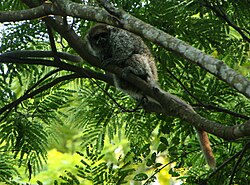Portal:Primates
The Primates PortalA primate is a member of the biological order Primates, the group that contains lemurs, the aye-aye, lorisids, galagos, tarsiers, monkeys, and apes, with the last category including great apes. With the exception of humans, who inhabit every continent on Earth, most primates live in tropical or subtropical regions of the Americas, Africa and Asia. Primates range in size from the 30-gram (1 oz) pygmy mouse lemur to the 200-kilogram (440 lb) mountain gorilla. According to fossil evidence, the primitive ancestors of primates may have existed in the late Cretaceous period around 65 mya (million years ago), and the oldest known primate is the Late Paleocene Plesiadapis, c. 55–58 mya. Molecular clock studies suggest that the primate branch may be even older, originating in the mid-Cretaceous period around 85 mya. Primates exhibit a wide range of characteristics. Some primates do not live primarily in trees, but all species possess adaptations for climbing trees. Locomotion techniques used include leaping from tree to tree, walking on two or four limbs, knuckle-walking, and swinging between branches of trees (known as brachiation). Primates are characterized by their large brains relative to other mammals. These features are most significant in monkeys and apes, and noticeably less so in lorises and lemurs. Many species are sexually dimorphic, which means males and females have different physical traits, including body mass, canine tooth size, and coloration.
Selected article
Archaeoindris fontoynontii is an extinct, giant lemur and the largest primate known to have evolved on Madagascar, comparable in size to a male gorilla. It belonged to a family of extinct lemurs known as "sloth lemurs" (Palaeopropithecidae), and because of its extremely large size, it has been compared to the extinct ground sloths of North and South America. It was most closely related to Palaeopropithecus, the second largest type of sloth lemur. Along with the other extinct sloth lemurs, Archaeoindris was related to the living indri, sifakas, and woolly lemurs, as well as the recently extinct monkey lemurs (Archaeolemuridae). It probably became extinct recently, around 350 BCE.
Its remains have been found at only one location: Ampasambazimba, a subfossil site in central Madagascar. The skeleton of Archaeoindris was massive and robust, and shared many traits with that of Palaeopropithecus. The arms were longer than the legs, but no hand or foot bones have been found for comparison with the other sloth lemurs. Size estimates based on the limited remains have varied widely, ranging as high as 244.1 kg (538 lb), but the most thorough statistical investigation estimates a mass of 160 kg (350 lb). There are varying opinions about the way Archaeoindris moved in its environment, ranging from tree-dwelling to ground-dwelling. Its skeleton suggests it was a deliberate climber that visited the ground to travel. The diet of Archaeoindris was mostly leaves, and its habitat—prior to human arrival—was a mix of woodlands, bushlands, and savanna, rich in lemur diversity. Although it was a rare lemur, it was still extant when humans first arrived on Madagascar, and it would have been vulnerable to hunting and habitat loss. Selected picture The white-fronted capuchin, Cebus albifrons, is a species of capuchin monkey, a type of New World primate, found in seven different countries in South America: Bolivia, Brazil, Colombia, Venezuela, Ecuador, Peru, and Trinidad and Tobago. The species is divided into several different subspecies, though the specific divisions are uncertain and controversial. CategoriesSelected species Least Concern (IUCN 3.1)|Least Concern The white-eared titi (Callicebus donacophilus), also known as the Bolivian titi or Bolivian gray titi, is a species of titi, a type of New World monkey, from eastern Bolivia and a small area of Brazil. It is a medium-sized monkey with a grey back, orange underside and distinctive white ear tufts. It has an omnivorous diet, eating fruits, other plant materials and invertebrates. It is predated upon primarily by raptors, though felids and other monkey species have been known to attack the species. It is a monogamous species and lives in small groups of two to seven members consisting of the pair and their offspring. The family group has a home range of 0.005 to 0.14 square kilometres (0.0019 to 0.0541 sq mi) and the adults have a complex vocal repertoire to maintain their territory. It is also known for its characteristic twining of tails when groups are sitting together. White-eared titis can live for more than 25 years in captivity. The white-eared titi population has a declining trend. The decline is believed to be mainly caused by human-induced habitat loss and degradation. Despite this, the International Union for Conservation of Nature (IUCN) classified the species as Least Concern in 2008 as it has shown adaptability to habitat disturbance and is found over a wide range. Did you know?
Primate lists
WikiProjectsThings to do
Associated WikimediaDiscover Wikipedia using portals |
















